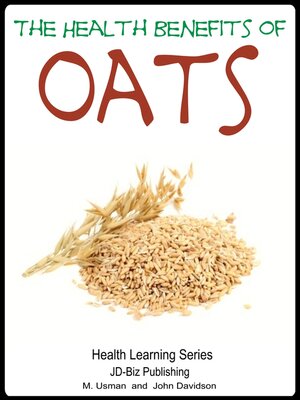
Sign up to save your library
With an OverDrive account, you can save your favorite libraries for at-a-glance information about availability. Find out more about OverDrive accounts.
Find this title in Libby, the library reading app by OverDrive.



Search for a digital library with this title
Title found at these libraries:
| Library Name | Distance |
|---|---|
| Loading... |
Health Benefits of Oats
Table of Contents
Getting Started
Chapter # 1: Intro
Chapter # 2: Nutritional Worth
Chapter # 3: Types of Oats
Chapter # 4: Selection & Storage
Chapter # 5: Are Oats Gluten-Free?
Health Benefits of Oats
Chapter # 1: Lowers Cholesterol Levels
Chapter # 2: Enhances Overall Cardiovascular Health
Chapter # 3: Lowers Type-II Diabetes Risk
Chapter # 4: Inhibits Cancer
Chapter # 5: Combats Childhood Asthma
Conclusion
References
Author Bio
Getting Started
Chapter # 1: Intro
Since the season of scientific researches in the 20th Century, the popularity of oats has been on the rise and they are gaining ever increasing respect in the scientific community as a nutritious diet. Oats are steadily but surely gaining over the breakfast market and each day a great number of people make the switch in search of the perfect breakfast. No doubt, all those cereal commercials hailing oats have a major hand in making people switch to oats too, but if it weren't for its mammoth-like health benefits, oats would never have had a chance to remain in the market.
But before diving straight into the specifics and health benefits of oats it would better to give a basic overview of oats and explain how they became one of the greatest grains on the planet.
The infamous oat, known in the scientific world as Avena Sativa, is a grain obtained from a cereal plan, grown for its seeds. The seeds interestingly are also known as oats and are the part of the plant that is mainly consumed; like many other grains, oats grow on stalks with their kernels distributed along a partial tree-like structure. After being harvested, the grains have their tough hulls removed before they can be made available into the market, either as whole or in milled formed.
When it comes to cultivation, oats are one of those plants that are able to withstand poor growing conditions; this is one of the reasons they were cultivated in Europe. Still, the best climate for growing oats is considered to be temperate. Their lower heat requirement during the summers and significant tolerance to wet weather makes them more compatible to variable regions than grains like wheat, barley and rye. On top of this, oats are an annual crop, meaning they can be planted in the autumn for a late summer harvest or during the spring for an early autumn harvest. The resilience & compatibility of oats can be judged by the fact that out of the total world oat produce for 2013, i.e. 21 million tons, Russia and Canada took the top spots with approximately 4 million and 3 million tons of oats respectively.
The modern oats are descendants of the wild ret oat, a plant that originated from within Asia. Oats have been in cultivation in various regions of the world for over 2000 years. Before oats were consumed as a food item, they were being used for their medicinal properties, a use which is now again gaining momentum. The cultivation of oats in Europe is widespread and historically, oat was an important commercial crop for the people of Scotland, Germany, Great Britain and Scandinavian countries.







